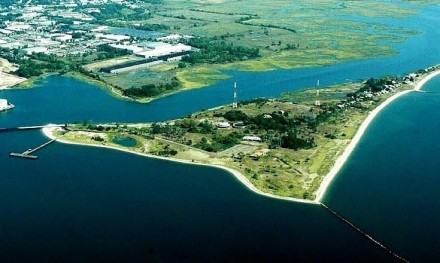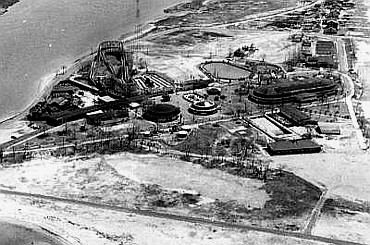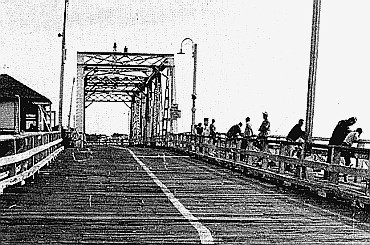
No one really knows if this experiment to reopen Pleasure Beach on Saturday will be successful. This effort by the city is certainly a leap of faith that hopefully will work out. But there’s nothing like bridging the present with nostalgia. The memories … oh the memories of Pleasure Beach. For me, Pleasure Beach was all about the 600-foot pier into the harbor, a bamboo pole, a frozen minnow on a hook with a float fishing for snapper blues, those ferocious little fighters. But first you had to cross that rickety clap, clap, clap drawbridge from Seaview Avenue (that burned about 20 years ago). We crossed it a bunch of times in a 1964 Dodge Dart that had a push-button transmission. There was something about that bridge that alerted a boy he was minutes from dropping a line with his father.
My father Emilio was a Sicilian immigrant who crossed the Atlantic aboard the Andrea Doria in 1953. He did not know a soul in the United States except for an uncle in New York and the woman from Bridgeport he married in Mascali, a tiny town on the island of Sicily.
My father loved Pleasure Beach because he came from an island. Pleasure Beach technically is a peninsula, but hey it’s pretty close to an island.

My father had an amazing childhood experience growing up in Sicily. Benito Mussolini pledged Italy’s support to Hitler during World War II, then one day an exiled George Patton showed up in Sicily with allied forces and my father’s eyes bulged at the site of amphibian crafts entering the island from the Mediterranean Sea. He could not believe his eyes, boats that moved on land. He had never seen modern conveniences such as a car, truck, telephone or a refrigerator.
At the time the allies invaded Sicily in 1942 my father was under the required age for military duty in the Italian army, and the man of the house. His father and oldest brother Giovanni were military men assigned to northern Italian and Greek isle posts. Emilio’s first true love was soccer and he toiled in various soccer leagues until a bout with typhoid fever rendered him bedridden and near death.
After the war my father, poor and hungry, was restless for a new life. In 1952, Sabina Fusci took Emily, her 22-year-old daughter, by the hand and escorted her across the Atlantic to Sicily to find a husband. Emily was born in Harrison New York, to a Sicilian father and Neapolitan mother who had friends in Sicily. She lived in Bridgeport. Within 10 days of meeting, Emilio and Emily were engaged, within two weeks they were married. Emily returned to her home in Bridgeport, leaving Emilio behind until he was cleared by immigration eight months later.

In 1953, my father scratched together enough cash to hop aboard the liner Andrea Doria and entered New York Harbor.
My parents settled on the East Side not far from Pleasure Beach, then a heralded northeast amusement magnet for the Big Band era. I was born in Bridgeport, but my parents raised me in Monroe where my grandparents bought a piece of property and my uncle and father built them a home. Monroe is landlocked and my father longed for the water. He took me to Pleasure Beach, often on Sunday mornings in the summer. We brought home buckets of snapper blues for the dinner table.
As a young journalist I crossed that bridge often to Pleasure Beach. Skippy Rastas, a Lithuanian, operated the Harbor Hut at the foot of the pier. He sold bait and tackle and this and that. And he grilled.
“Try this,” he said to me.
“What is it?”
“Eat it first and maybe I’ll tell you.”
“Not bad!”
“It’s shark.”
It was the first time I tasted mako shark.
Later in life I was hired by Donald Trump to handle his media relations in Connecticut. Trump had all sorts of ideas about developments in Bridgeport. His favorite piece of property in Bridgeport?
“Pleasure Beach.”
Your memories?

More about Pleasure Beach from my book Only In Bridgeport.
Pleasure Beach is perhaps the one park left that is a sad reminder of the demise of the premier summer resorts of New England dating from the Gay ’90s. Tourists from throughout the northeast traveled by trolley and ferryboat to visit the original 37-acre area also known as the “Million Dollar Playground.” J.H. McMahon and P.W. Wren, two wholesale liquor dealers and land developers, turned the barren, sandy island into an amusement park in 1892. Three years later, a brochure of Pleasure Beach advertised a roller coaster, boardwalk, miniature railroad, skating rink, arcade, merry-go-round, a 5000-seat coliseum, wooden horse rides on a rail (for which the park later took the name Steeple Chase Island before returning to its original name) and a track that was one of the prestigious stops on the bicycle racing circuit. It also boasted of the Pleasure Beach legend, which alleges that the island was chosen by Captain Kidd for burying vast treasures.
“No exorbitant prices, an honest dollar’s worth for all,” was the motto. The Pleasure Beach Cafe served broiled lobster and soft-shell crab for 50 cents, broiled bluefish for 40 cents, and clams on the half shell (when local oyster beds were abundant) for 25 cents a dozen.
McMahon and Wren, as well as other private operators, ran into some financial troubles with the help of the fires that have cursed the island through the years; the first came on August 18, 1907, and destroyed the grandstand and weaving horse rail ride. The Bridgeport Board of Park Commissioners bought the park for $220,000 in 1919 and took over full operation in 1938, running the park during its most glorious days. Through the Depression it was a place to relax–-on the glittery carousel, roller coaster or in the big-band ballroom. In its heyday, Pleasure Beach attracted hundreds of thousands each year. In the 1950s the amusement center began to falter through the city’s willingness to allow it to deteriorate and due to declining tourist revenues.
The park became a campaign issue in Samuel Tedesco’s victory over Jasper McLevy in 1957. The Tedesco administration tried reviving the park through a massive public-relations campaign, but the amusement center closed in 1960 and steadily sank into disrepair. The leftover buildings, ballroom and rides fell victim to fires, vandals and wrecker balls. Just about every year since, Pleasure Beach has been promoted as the ideal location for a jai alai fronton, dog racing track, gambling casino, college campus, jail or resort center. Lots of talk and ideas, but little else. The 53-acre peninsula (the U.S. Army Corps of Engineers used landfill dredged from Bridgeport Harbor to increase its size by 16 acres and connect the island to Stratford in 1947) has resembled a ghost town except for the 600-foot T-shaped pier, the last relic of the former amusement center that survived as a local fishing haven for snapper blue anglers. The pier sustained heavy damage when Hurricane Gloria swept the area in late 1985. In 1995, a fire ravaged the bridge that connected the East End to the peninsula. (Exorbitant costs have prevented bridge replacement, according to city and state officials.)


Thank you for your memories Lennie, great!!! I lived in Yellow Mill Village as a young girl and remember my mom walking us to Pleasure Beach for a day of “rides” and games and playing with the other kids from the village. It was like going to Disney World in the ’50s; the greatest thrill of our young lives. As a teenager I remember meeting my friends there, it was our experience of a night out. Pleasure Beach, as I knew it, is part of all my childhood memories. I sincerely hope this attempt to open it again is a start for others to carry memories!
Lots of reminiscing about the past! Let’s deal with today and the future and move forward!
Lennie, thanks for that wonderful memory. So many of us who came of age in the ’50s and ’60s in Bridgeport and ‘burbs could tell similar tales. Wingnut, perhaps you could mimic “Criswell Predicts” and provide us with your view of the future for our fair city.
Who is going to be in charge of spraying for bugs? If I remember correctly, there were many. It would be terrible for people to get off the taxi only to find themselves in the center of some sort of infestation.
Really!!!
I think initially there will be interest, but in a few weeks the curiosity will wear off, and with the free rides over, who is paying for the gas for the boats, the two policemen who will be there every day, public works employees who have to get garbage and clean restrooms, etc.?
The history lesson is part of the advertising deal Lennie cut with the city.
Really!!!
Love the story! Realistically, there are no present-tense tales regarding Pleasure Beach. I believe nostalgia is a decent ramp-up for Pleasure Beach’s grand entrance into the new Millennium. It’s the only ramp-up.
That point taken, I am also a gal who spends all her time in the present. I am really looking forward to the here-and-now Pleasure Beach identity!